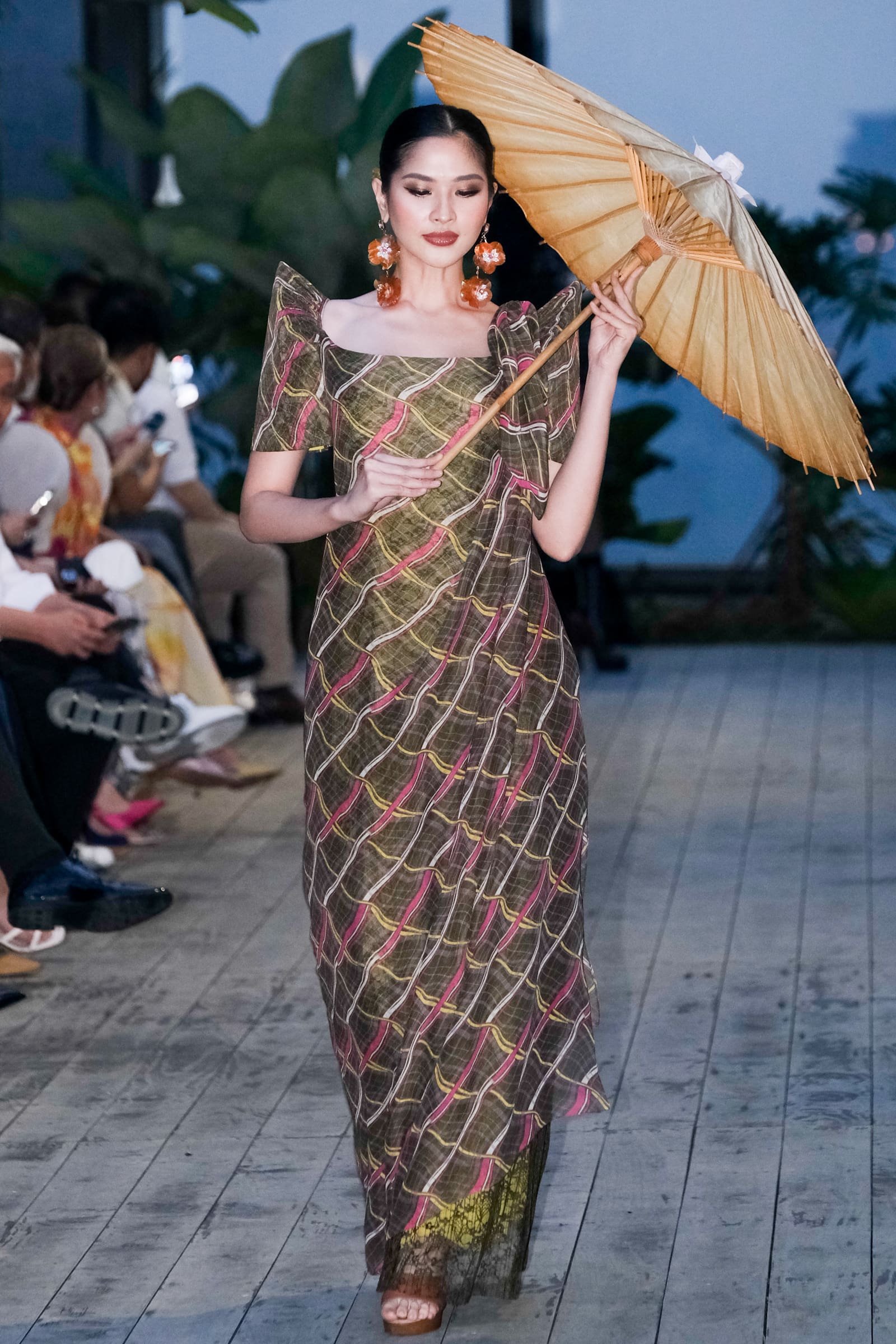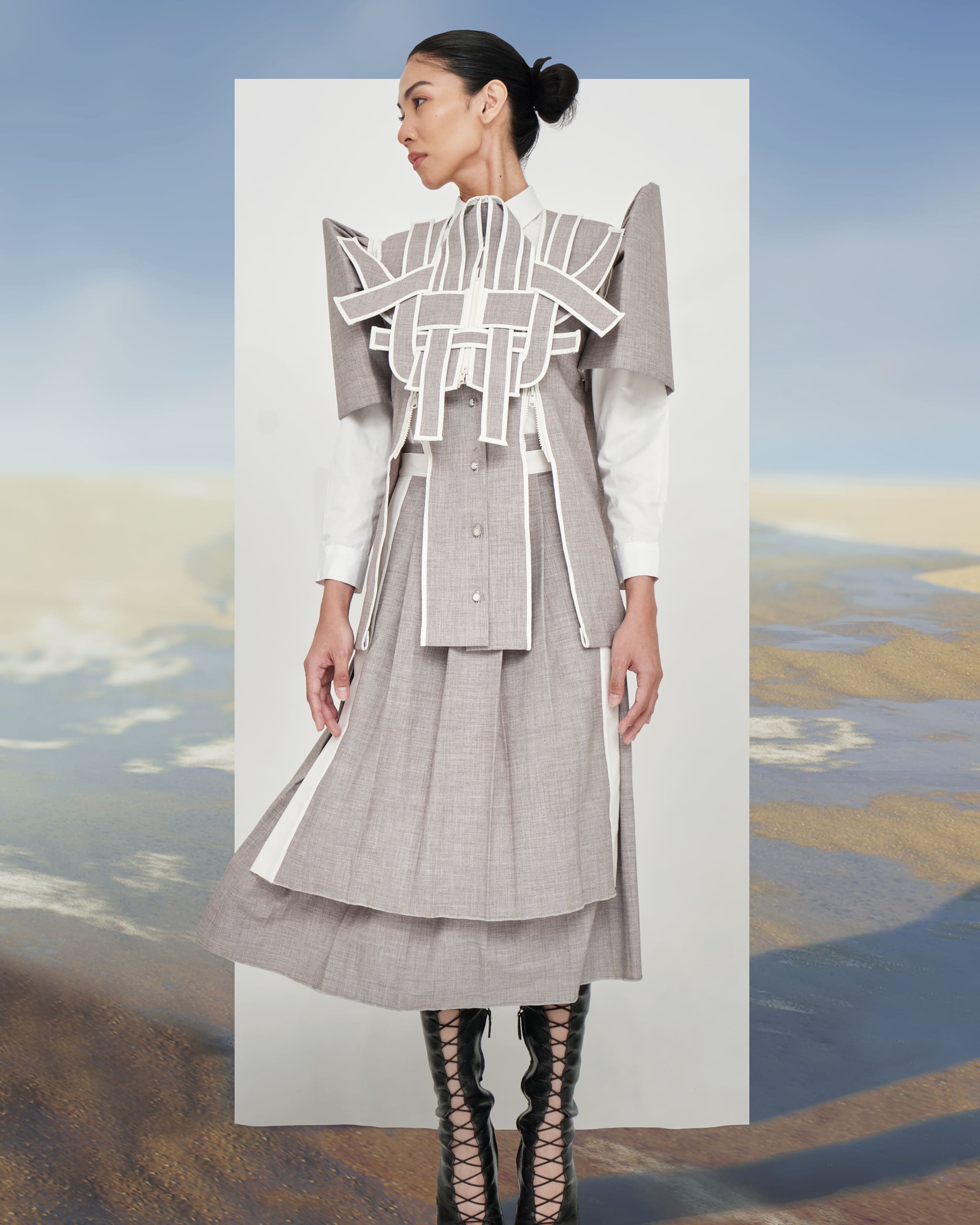Bon Hansen balintawak. Photograph by Shaira Luna, landscape by Bianca Carague.
These pioneering talents are bringing Filipino heritage into the metaverse.
For the December 2022 – January 2023 issue of Vogue Philippines, Filipino heritage was welcomed into the realm of the virtual. The editorial, titled “Paraiso” was built from scratch by a team of creatives. Several different designers from TernoCon allowed their creations to be digitized and shot in a virtual Filipino paradise; a monumental feat aimed at connecting the past and the future into a conceptual present.
Among the designers chosen for this story are three young talents teeming with a fresh new proposition for the iconic Filipino garment; Abdul Gaffar, Bon Hansen, and Dinnes Obusan. Vogue Philippines speaks to them about their journey into design, and how they felt bringing their pieces into the metacraft.
Urbanizing The Traje De Mestiza
Abdul Gaffar always grew up with a penchant for drawing clothes. Coming from the province, fashion design wasn’t a career path he was aware of until high school. After moving to Manila at the age of 18, he decided he wanted to pursue design seriously, and asked his parents if he could give it a try. “I’m very grateful that they were very supportive of me. They even went with me to Slim’s Fashion and Arts School to enroll.”
“Growing up I only [saw] the terno as our national “costume”, having only seen it worn in buwan ng wika or traditional and cultural presentations. I did not understand it,” he says. “But since studying at fashion school, learning firsthand how to construct a terno sleeve, and then later on learning about its history and significance, my appreciation for it grew exponentially.”


“It is not just a costume, it is a dress that has a very deep history, a history that tells the story of our country through a dress. It evolved and adapted through time depending on the needs of Filipino women.”
Gaffar found himself excelling in his vocation. He went on to join Ternocon and work closely with and learn from Gino Gonzales. “Because of that, I learned more about the details and history of the terno, or in this case the Balintawak, which was very important for me before I can reimagine something.”
The designer chose to go with a romanticized yet urbanized version of the traje de mestiza. His design was later brought to life within the metacraft for Vogue Philippines. “It was amazing!” Gaffar tells us about his design’s journey from fabric to data. “It was a very tedious and meticulous process, somehow similar to creating a garment in real life… I wish I [could] make a full collection in the metaverse, where it seems like the sky is the limit with our imagination.”
Melding Tradition With Menswear
Bon Hansen had always dreamed of becoming a fashion designer, but never thought he would be able to put himself through fashion school. Right after he graduated with his bachelor’s degree, a family friend gave him the opportunity to apply for a full scholarship grant to study fashion. “If not for that person, I would not [have been] able to achieve my dreams.”


Hansen eventually found himself in Ternocon, working to reinterpret a historic piece of Filipino history and identity. Though he gravitates towards menswear design, his skills in tailoring lent well to the technical aspects of crafting a terno. “I am much of a technical designer, so it is important for me that my background and expertise are visible in my designs.”
Like Gaffar, Hansen hadn’t heard of the metaverse until he was approached by Vogue Philippines. “The process is quite [a lot] to digest. But I was amazed with the whole concept,” he says. “[The] terno is our national identity. For me, it symbolizes everything that makes us Filipino.”
Redefining History For The Next Generation
Dinnes Obusan‘s path to fashion wasn’t a straightforward one. He found himself on the hunt for work after losing his job at his parish, which proved to be difficult since he was only a high school graduate. After noticing his talent, a priest at their parish found Obusan a patron who put him to school at Slim’s School of Fashion and Arts.
Obusan worked hard with the opportunity he was given and managed to create incredible work even with cheap or upcycled materials. The school noticed his skill and tenacity and took him on as its first scholar. The budding designer went on to be the only student with two pieces on display at Ternocon in 2018.
Over the years working at his craft, Obusan began to refine his vision and design style. “Bilang isang designer mailalarawan ko ang aking sarili na classic dahil sa pagawa ng design mas gusto ko yong traditional style pero may kunting twist para maging modern at akma sa panahon ngayon,” he tells us. [As a designer, I would call my style more classic, because I prefer traditional styles with a little twist to be modern and fit today’s times.]
To Obusan, redefining the terno was no casual task. It was a matter of bringing our national dress into the modern age, in a time where many people have forgotten its origins and significance.


“Hindi lahat marunong ng proper way lung paano ito gawin, lalo na ang terno sleeves. Kaya malaking bagay na magkaroon ng ternocon at nagkaroon ng mga workshop kong paano ito gawin.” [Not everyone knows the proper way [to make a terno], especially the terno sleeves. That’s why having Ternocon and workshops that teach people how to do it are so important.]
The designer says he enjoyed every moment of the process of bringing his design into the virtual realm. “Parang ang simple lang kasi nong balintawak terno ko tapos mas napaganda pa nong mapunta sa metaverse, ang saya.” [It seems like my Balintawak terno is so simple, but it got even better when it was brought into the metaverse. So happy!]
Obusan says he couldn’t stop looking at the editorial when he finally got his copy of the magazine. He brought the copy home with him to the province and couldn’t wait to show everyone. The designer now dreams of setting up his own atelier and hiring his own team to help bring his creations to life.
